British Museum, Sept 2006
A Saturday afternoon visit
(Photos/words © urban75, Sept 2006)
One of the largest and most important museums of human history and culture on the planet, the British Museum was established in 1753, originally based on the private collection of the physician and scientist Sir Hans Sloane.
Opening to the public on 15 January 1759 on the current site, the museum has expanded over the centuries, spawning several branch institutions including the British Museum (Natural History) in South Kensington (1887) and the British Library (1997).
The Museum's collection numbers over seven million objects from all around the world and admission is free.
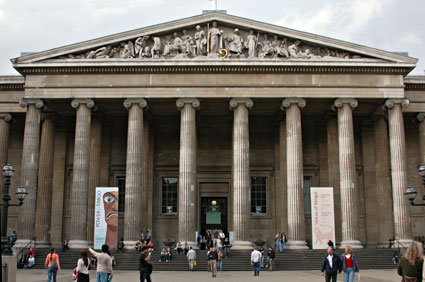
Replacing the original 1686 Montagu House, the current building was designed by the neoclassical architect Sir Robert Smirke and finished in 1845.
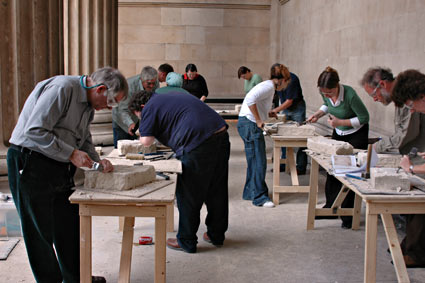
Just outside the British Museum's entrance were a host of stone carvers from Arts Express in Peckham doing their clinky, chipping-away thang.
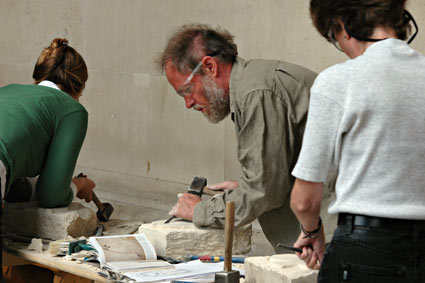
Close up of an earnest chipper.
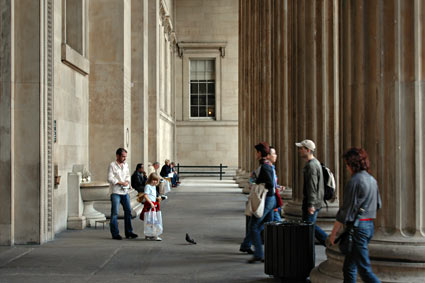
Entrance to the museum. The Great Russell Street facade features 44 columns in the Ionic order, each 13.7 metres high and closely based on pillars at the temple of Athena Polias at Priene in Asia Minor.
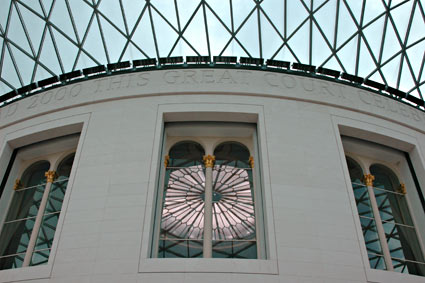
Designed by the architects Foster and Partners, the Queen Elizabeth II Great Court sits in the centre of the British Museum.
At the centre of the Great Court is the circular Reading Room, previously used by the British Library.

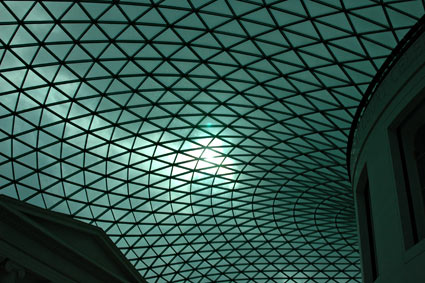
Opened in December 2000, the Great Hall is the largest covered square in Europe, with the glass and steel roof being constructed with 1,656 uniquely shaped glass panes.
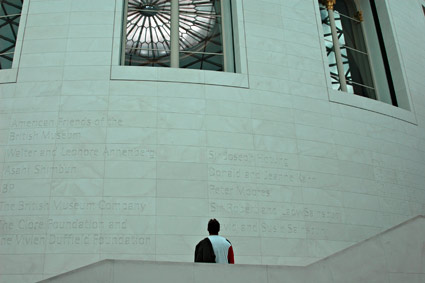
Visitor examines the carved list of Museum sponsors.
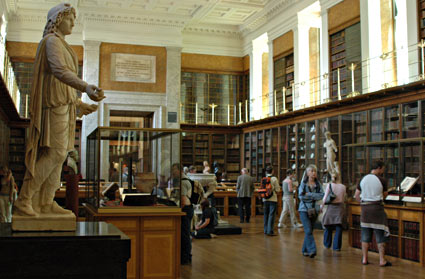
I visited the Museum with Eme (from the Actionettes) and because she was paying far more attention than me, I'll quote her excellent blog here:
"Inside we wandered amongst the exhibits in the Enlightenment Gallery - objects arranged in the way people would have categorised them in the 18th century, many of them bearing C18 labels, or set upon C18 mounts.
The whole room feels like a kind of cabinet of curiosities or an amazing collection in an eccentric uncle's library. In fact the room is called the King's Library, where the books of King George III - that he left to the museum after his death 1820 - were housed before being sent to the British Library."

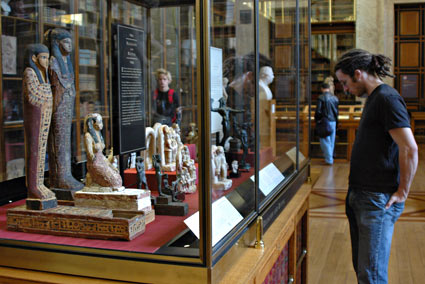
Checking out some Egyptian exhibits.
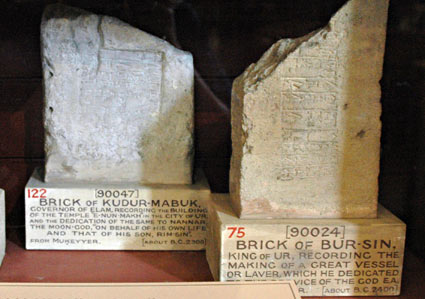
A 'Brick of Kudur Mabuk' and a 'Brick of Bur-Sin.'
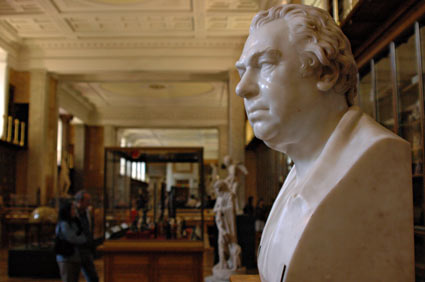
Looking along the delightfully old-fashioned room.

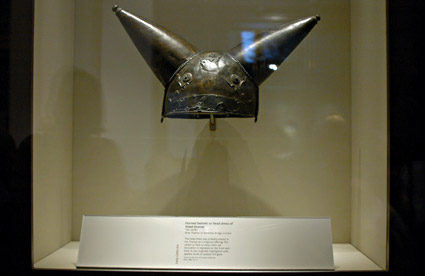
Next door was another fascinating room - I'll let Eme take up the commentary again:
"Also, if you get the chance, check out Room 2 where selected objects from Japan, Iran and Britain are on display while their permanent galleries are being refurbished.
Amazing Bronze age finds from the River Thames (a 350 - 100 BC bronze shield inlaid with glass at Battersea Bridge, 150 - 50 BC bronze horned helmet found near Waterloo Bridge, a 1 AD Roman helmet near Kew and the bronze head of the Emperor Hadrian (2 AD) from near London Bridge!
There were also weird neolithic stone balls, hundreds of which keep showing up in Scotland, their carving reminded me of sculptures by Peter Randall Page.. Oh, and they have their 'hands on' volunteers in there too - I held an axe head from Norfolk carved *6000* years ago! (luckily you hold objects in both hands over a padded table - phew!)"
(Pictured above is a 'Horned Helmet or head dress of sheet bronze,' 150-50BC, found in the River Thames, near Waterloo Bridge.)
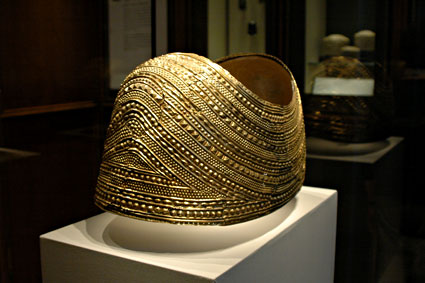
The Mold gold cape - an amazing Bronze Age cape, from around 1900-1600 BC and found in Mold, Flintshire, North Wales.

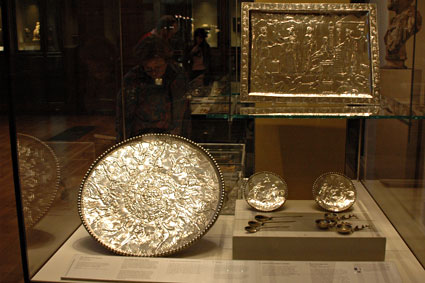
The breathtaking 4th Century Mildenhall Treasure, the finest set of Roman table silverware ever found in the British Isles.
The treasure was uncovered on a snowy January afternoon in 1943 by Suffolk ploughman Gordon Butcher.
His boss took some pieces home and stuck it on his mantelpiece and it was only after the war that a chance visitor pointed out that the items were Roman silver and not pewter.
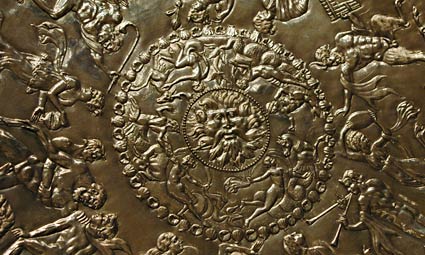
Close up detail of the silver Great Dish, a 60.5cm (2ft) monster weighing 8.256kg (over 18 pounds).
The design shows a bunch of dancing drunken revellers - including Hercules, Pan, and Bacchus, the god of wine - with an
inner frieze depicting sea monsters and nymphs.
Stuck right in the middle is the face of a sea-god, reckoned to be either Neptune or Oceanus.

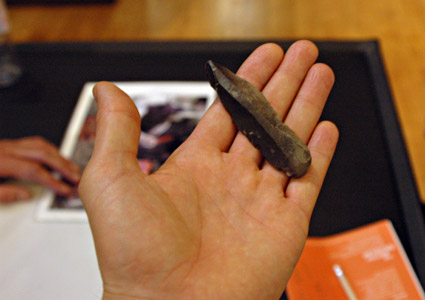
Here's me holding a 14,000 year old flint! Very 'umbling.
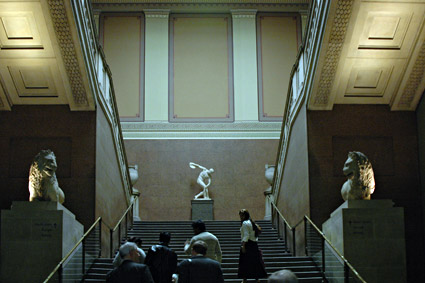
Impressive stairs to the first floor.
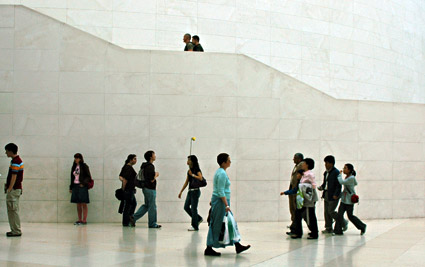
People coming and going in the Great Hall.
I love the British Museum - even if ol' Frank had a problem with the place:
Frank Sinatra - A Foggy Day Lyrics
(George Gershurin, Ira Gershurin)
[Recorded December 19, 1960, Los Angeles]
A foggy day, in London town, it had me low, and it had me
down
I viewed the morning, with much alarm, the British Museum, had
lost its charm
How long I wondered, could this thing last, but the age of
miracles, it hadn't past
And suddenly, I saw you standing right there
And in foggy London town, the sun was shining everywhere
|

